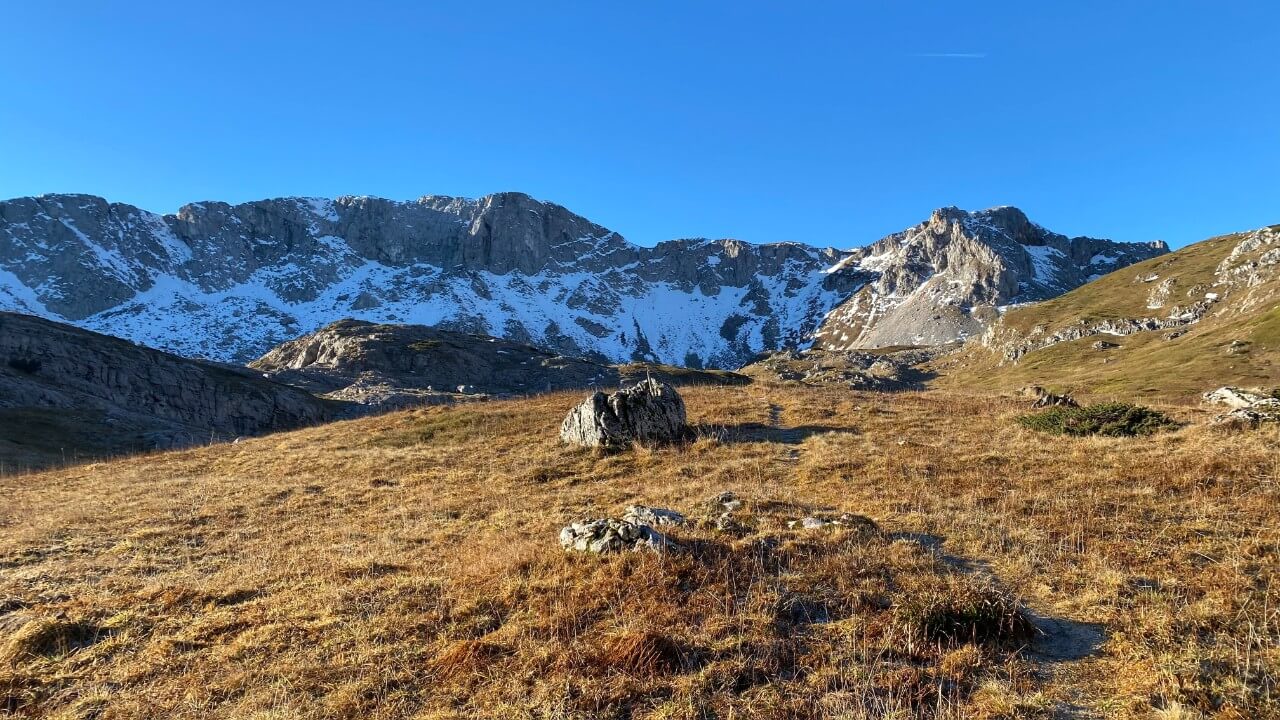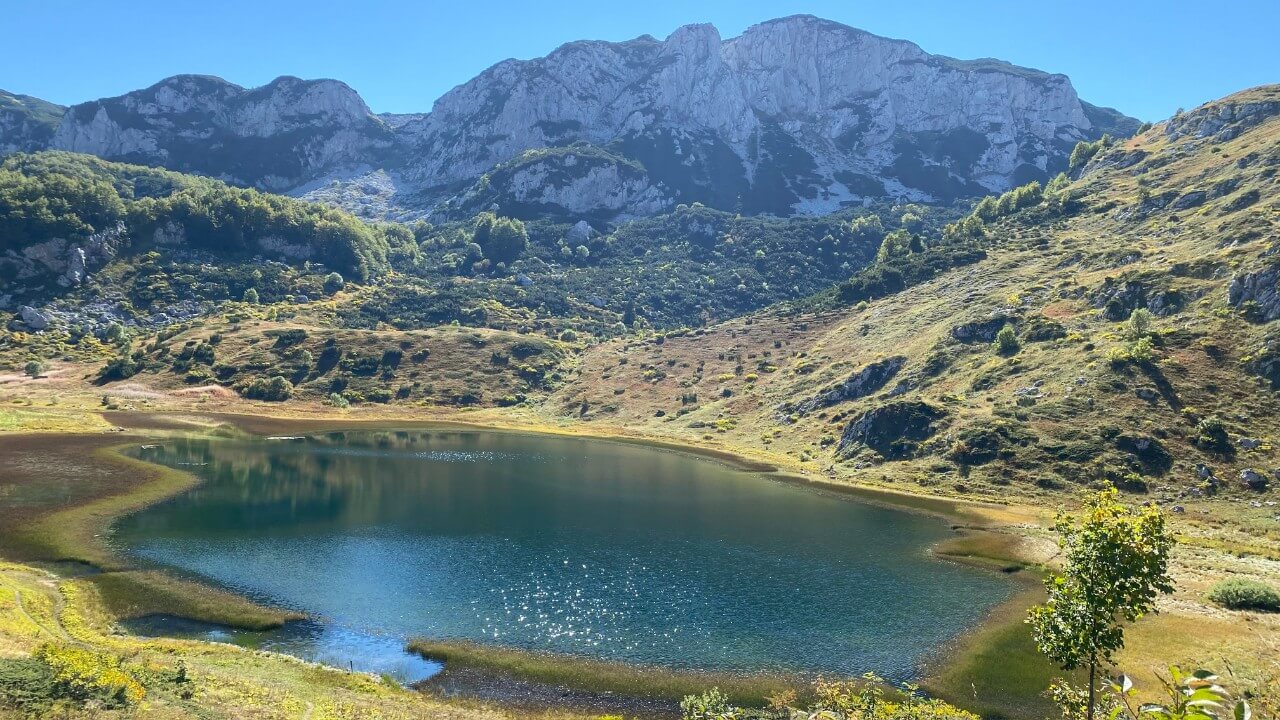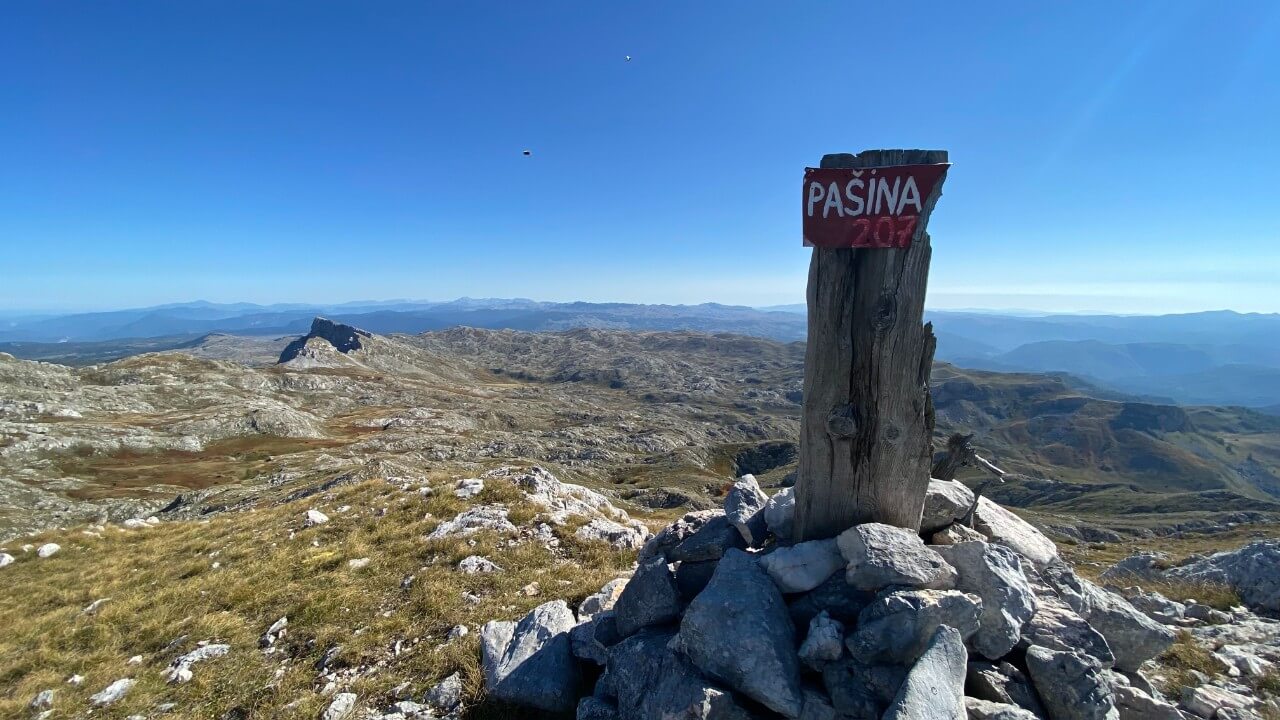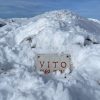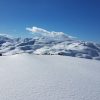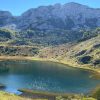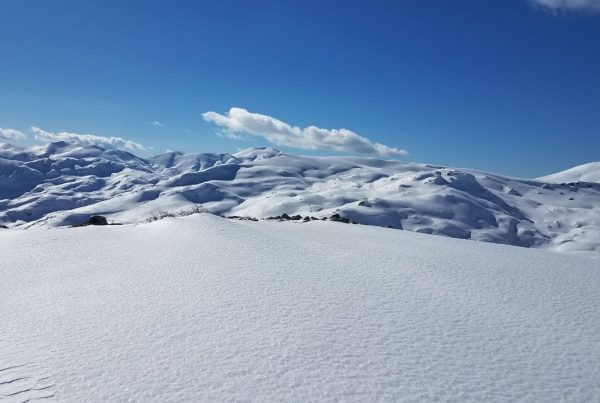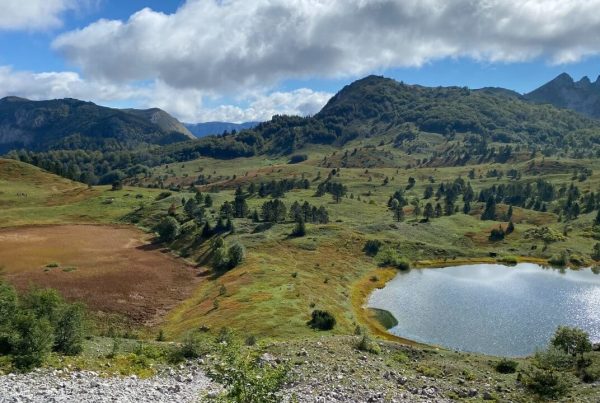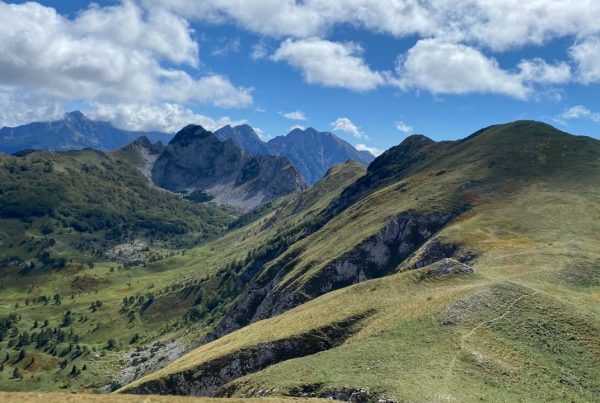Treskavica, one of Bosnia and Herzegovina’s most stunning mountains, lies to the east of the Rakitnica spring. Treskavica mountain is situated in central Bosnia, around 30 kilometers south of Sarajevo. The highest peak of Treskavica mountain is Mala Ćaba, also known as Đokin Tower, rises to 2086 meters above sea level. It is located above the towns of Trnovo and Kalinovik, between the rivers Zeljeznica, Ljuta, and Neretva. Treskavica mountain borders Mount Lelija to the south and Bjelasnica to the north. On clear days, the stunning view from the mountain of Treskavica extends all the way to the mountains of Montenegro.
If you are here just to find hiking GPS trails and tracks on Treskavica mountain, you can download our tracks in the section on the link with all of our Treskavica trails and tracks.
Also we will put the links for all of our Treskavica hiking trails at the end of this text.
How to reach Treskavica mountain?
There are several routes to reach Treskavica mountain. One of them starts from Trnovo, passes through the village of Turovi, and leads to the mountain house on Sustavac via a rough gravel road. If you are not sure how to reach village of Turovi, you can just simply follow this link to a google maps directions from Sarajevo to Turovi village.
From village of Turovi, a marked mountain trail heads southwest to Kozija Luka, where a huge mountain lodge once stood before it was destroyed during the war. This lodge was the largest one in the former Yugoslavia, which is a testament to the popularity of Treskavica for hiking and mountaineering enthusiasts.
After passing Kozija Luka, the marked trail continues west towards Šišan, a scenic pass on Treskavica that provides breathtaking views of the summit ridge. It’s a popular spot for hikers and mountaineers to take a break and enjoy the stunning scenery.
The Šišan Pass offers stunning views of the summit ridge of Treskavica mountain and leads to the Veliko Lake.
To reach Mount Treskavica, you can also take the route from Sarajevo via the Olympic mountain Bjelašnica and continue to the village of Dujmovići, located beneath its northern slopes. From there, a southward paved road leads over the Čardak elevation to Jablan dol, and under the western rock of Oblik peak, towards the Trokun hot spring and Crno Lake, which can be reached in about three hours on foot. This route offers stunning views of the mountain and is a popular choice for hikers and mountaineers.
You also have the option to go from the village of Šabići, near the Rakitnica river. However we’ll describe this route in the part about the highest peak of Treskavica, Mala Ćaba.
Mountain Lodge on Treskavica biggest lake, Veliko jezero
Located below the Šišan Pass is the stunning Veliko Lake, where the Treskavička Jezera Mountaineering Club has built a mountain house. The club consists of local mountaineers and nature enthusiasts from the nearby village of Turovi. This mountain lodge serves as the central hub for exploring Treskavica mountain, with almost all nearby peaks accessible from here. Peaks such as Oblik, Lupoč, Mala Ćaba, Đevigrad, Opaljeni Kuk, Barice, Pašina Planina, Klekova Glavica, Kota 2,048, Zubovi and more can be climbed from this base.
And within a few days spent in this mountain house you can explore almost the whole mountain of Treskavica. This house is always open and while during the summer season there is a host in the house, in the winter there is no one here. Still you can visit and sleep in the house. However, it’s worth mentioning that you should book a stay with the members of Treskavička Jezera Mountaineering Club.
To reach the Veliko Lake and the mountain house, one needs to hike for about 3 hours from Turovi village. It’s an excellent spot for hikers and mountaineers to rest and rejuvenate while enjoying the beauty of Treskavica mountain.
Mines on Treskavica, greatest danger of this mountain
Oblik peak’s 100-meter-high rock, along with Zubovi, Ćabanske rocks, and Treskač ranging from 100 to 200 meters high, were famous for alpinist activity with alpinistic ascents of varying difficulties. However, during the war, Treskavica mountain became the site of fierce battles, and the danger of residual minefields and explosive devices is still present. Therefore, we advise thorough research and hiring an experienced local guide before embarking on hiking or mountaineering adventures in Treskavica mountain.
While Treskavica mountain is a popular destination for mountaineers, fishermen, and hunters in Bosnia and Herzegovina, it has not yet been fully demined since the war. Most popular destinations on Treskavica mountain are the areas of Veliko and Crno lakes, just below the highest peak of Treskavica, Đokin Toranj or Mala Ćaba. But even though it is often crowded with visitors, these areas are risky too if you don’t strictly follow the marked route.
Although hunters can explore the most remote parts of the mountain with a guide, caution is necessary due to the presence of wild animals and residual mines.
Treskavica highest peak, Mala Ćaba or Đokin Toranj – how to reach it?
For mountaineers, climbing to Đokin Toranj or Mala Ćaba, the highest peak of Treskavica mountain, offers breathtaking views of the surrounding high mountains. However, it’s recommended to do so during winter with a thick snow cover or to hire an experienced local guide to avoid the dangers of residual mines.
It’s interesting how this peak has multiple names, and this is a really common thing with peaks in Bosnia and Herzegovina. They often tend to have various names for the same locations due to some political or national tensions. Peak Mala Ćaba is no exception to this, so there is a controversy surrounding the name of Treskavica’s highest peak.
Some prefer “Đokin Toranj” (“Đoka’s Tower”) for its association with their team, while others prefer “Mala Ćaba” (Little Kaaba) for their own personal reasons. Those who want to avoid offending anyone suggest the neutral name Pakliješ. It’s important to note that these three names refer to completely distinct features.
The area known as “Pakliješ” is situated to the south of the peak of Treskavica mountain. This can be verified on old maps. The name “Pakliješ” is derived from the word “Pakao” which means “Hell” in Bosnian. Anyone who reaches the top and looks towards this area will understand why it’s called that. The terrain is inhospitable and appears impassable due to large sinkholes. Moreover, it was likely mined, which may have contributed to usage of this name during the war. So crossing through this area can feel like hell now.
Đokin Toranj (Đoka’s Tower) is a metal shelter designed to protect hikers from wind and other weather conditions. It was modeled after two existing structures, one on Mosor and the other on Triglav, the latter of which still stands today. Unfortunately, the metal shelter on Treskavica mountain did not survive the war and years of neglect without maintenance. Today, only the door next to the peak mark remains, unless a strong wind blows it away. It is important to note that the shelter was not built by Đoka, but by an engineer who was an avid mountaineer. He refused to have the building named after him out of modesty, which would have resulted in a different name for the peak.
The only historical name for the peak is Mala Ćaba (The Little Kaaba), which originates from the practice of visiting peaks during religious holidays. The villagers living at the foot of Treskavica mountain have been using an old name since ancient times, which is associated with the tradition of visiting the mountain peaks on certain days of the year. This practice had a religious significance, as people paid their respects to the deities or God they worshipped during that period. Initially, these deities were associated with natural phenomena and assigned properties related to nature.
However, the original name or names have not been preserved. And since these customs were integrated into monotheistic religions, the peak of Treskavica was named after the holy site of the Kaaba in Mecca, with an allusion to its religious significance. So the name has evolved into “Mala Ćaba” in Bosnian.
To reach the highest peak of Treskavica mountain, there are two main routes to choose from. The first route begins in Trnovo and takes us through Turovi village, and then followed by the mountain house on Sustavac, Kozija Luka, Šišan, and Veliko Lake, before arriving near the peak at Hercegovačka Vrata pass. Most of the hikers or climbers will take a rest at the mountain house on Veliko Lake and then they will continue toward Hercegovačka Vrata pass. From this pass, it takes only around 30 minutes to climb to the peak of Mala Ćaba from the northern side.
The second route starts at the village of Šabići near the Rakitnica river and takes us up the western slopes below Treskavica peaks of Ogorjeli kuk and Đevigrad, via Ploča, to the Štirni do plain, and finally along the western side to the peak of Mala Ćaba. These routes offer a great opportunity for hiking and mountaineering enthusiasts to explore the stunning landscapes of Treskavica mountain.
Snowmobiles can be used on forest roads to get closer to the Treskavica mountain top. And some experienced mountaineers use bear tracks on this road as a good trail, especially in March. However, these tricks can help only local, experienced hikers or mountaineers. For a regular visitor, both climbs require overcoming high altitude and covering 10 to 12 km. In winter, a long and tiring day is required, with the possibility of bivouacking – sleeping in the open air.
For the winter ascent of Treskavica mountain’s highest peak Mala Ćaba, the knowledge of alpine and winter mountaineering is required. Also, high-altitude mountaineering equipment is necessary. It is highly recommended to use a local mountaineering guide and have good fitness, knowledge of ski touring, basic climbing experience with ice axe and crampons, and a willingness to bivouac.
Mount Treskavica and its natural lakes
Treskavica Mountain is a must-visit destination for all hiking and mountaineering enthusiasts. This mountain boasts large and dense coniferous forests, as well as vast meadows with lush grass, providing breathtaking views. The diverse terrain of Treskavica offers something for everyone, from rocky areas that offer adrenaline-fueled experiences for climbers and mountaineers, to serene natural lakes, including Veliko Lake and Crno Lake, which are ideal for swimming and relaxation after a long hike.
However, in addition to all the aforementioned attractions, Treskavica mountain boasts five stunning glacial lakes that serve as a prominent reminder of the ice age. These lakes are located at an altitude of over 1500 meters and are a unique natural wonder and a popular destination for hikers. The glacial lakes on Treskavica mountain, namely Veliko, Bijelo, Crno, Platno, and Malo, are home to diverse flora and fauna, making them a valuable ecosystem.
In the late 1950s, attempts were made to artificially stock these lakes with fish. However, only the Veliko Lake was successful, and it now boasts a population of trout.
Veliko Lake on Treskavica Mountain
Veliko Lake, located at an altitude of 1550 meters, is the largest and most stunning of the five glacial lakes on Treskavica Mountain. Its crystal-clear water and unspoiled surroundings provide unforgettable experiences, particularly on hot summer days, although the lake’s charm and appeal remain undiminished throughout the year.
With a length of approximately 300 meters, a width of around 150 meters, and a depth of roughly 5 meters, Veliko Lake is home to impressive rainbow trout. However, the approach to the lake can be challenging due to the presence of minefields from the previous war, so it’s not recommended to visit without a reliable guide. Or you should carefully research and plan your trip. It’s strongly recommended to avoid walking beside marked hiking routes.
Crno Lake on Treskavica Mountain
Crno Lake, or “Black Lake,” is situated between the peaks of Mali Ljeljen and Illijas, less than a kilometer northwest of Veliko Lake, at an altitude of 1675 meters. With a length of 150 meters, a width of 100 meters, and a depth of 3 meters, it is a smaller but no less stunning glacial lake on the mountain. It is a popular destination for hikers and mountaineers seeking to explore the natural beauty of Treskavica.
Bijelo Jezero, the White Lake, of Treskavica Mountain
Bijelo Jezero or White Lake, is situated about two kilometers southwest of Veliko Lake, almost below the highest peak of Treskavica, Mala Ćaba. This lake is located at the highest altitude of all the lakes in Treskavica, at 1697 meters. The lake is approximately 140 meters long, 70 meters wide, and 0.5 meters deep. Although this lake doesn’t have any fish, it’s still a must-see for hikers and mountaineers seeking stunning natural scenery in Bosnia and Herzegovina.
Although Treskavica is one of the most beautiful mountains in Bosnia and Herzegovina, it unfortunately remains one of the most polluted due to the presence of mines left over from the last war. As such, it’s important to exercise caution when hiking or mountaineering in the area. However, winter ascents can be less risky if approached with the proper precautions, such as traveling on a thick layer of snow with skis.
Treskavica Mountain and it’s Natural spring water
Treskavica mountain is known for its abundance of water sources, with a local legend claiming that there are springs for each day of the year. In addition, there are numerous folk tales and legends that revolve around the mountain and its springs.
There are numerous folk tales and legends associated with Treskavica mountain, including one about fairies and elves. Once, two friends who were late returning home from Sarajevo found themselves stranded on Treskavica mountain. Afraid of the mystical creatures said to inhabit the area, they agreed to stay awake all night and turn each other’s legs and put their feet together while facing each other. They fell asleep in this strange position. Around midnight they were awakened by the sound of fairies playing nearby. The fairies stopped their game and circled around the men, amazed by what they saw – two-headed, four-legged creatures.
The fairy in charge decided to spare this man’s life saying: “By all 365 Treskavica springs, I have never seen such a miracle of a man, with two heads and four legs. I will spare his life, let him go, I want the whole world to laugh at him.” As the fairies left, they shared this knowledge of the 365 Treskavica springs. And this legend still persists in the villages surrounding the mountain.
Treskavica is rich with numerous hot springs that never dry up even in the summer. Many of these springs are conveniently located near popular hiking trails, making them the perfect spot to take a refreshing break and hydrate with clean mountain water.
Here are some of the most significant and easily accessible springs on the Treskavica mountain:
In the central area of Treskavica, there are several notable natural springs, including Trokun Spring, Spring under Oblik, Spring under Ilijaš, Pašino Spring, Konjska Spring, Ušljiva Spring, and Kada Spring on Ljeljen. These sources of fresh, clean water offer a refreshing break for hikers on the mountain trails.
On the eastern side of Treskavica, there are several notable springs, including the spring on Sustvac, the spring on Palež, the spring on Skok, the spring on Kozja luka, the spring on Spasovača, the spring of river Bistrica, Vratanjska Voda,the spring on Simovića bara, and the spring on Gvozno polje.
On the southern side of Treskavica, you can find the refreshing Prapatnica Vrelo, as well as Vrela in Vrhovina, Gornje vrelo, Obrutak, and Djevojačko vrelo. Moving to the north, there’s Željezničko Vrelo near Godinje, Igrište on Dujmovska hills, spring in Jablan dol, Ždrebanovo spring on Kučare, spring on Barice, spring on Pandurica, spring on Poljice, Zucina spring, and Fatina voda. On the western side, you can find Gladna voda under Ogorjeli Kuk, Baletina water on Valovica, spring near Ploča, God’s water under Opaljenji kuk, Štrcalo and spring in Štirno dol, spring under Oblik, White waters, spring on Lanište, Studeno vrelo, spring on Gornja and Donja Bara.
This is definitely one of the unique mountains in the whole world when it comes to its richness with the natural spring water which you can drink without being afraid of any kind of diseases or pollution.
Full list of hiking trails on Treskavica mountain:

